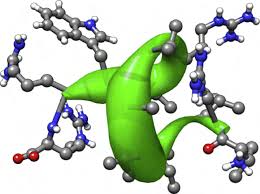 By Dr. Katharine Sedivy-Haley, PhD alum, Hancock Lab
By Dr. Katharine Sedivy-Haley, PhD alum, Hancock Lab
Host defense peptides – in addition to their synthetic analogues, innate defense regulator (IDR) peptides – have recently gained attention as a new strategy for treating challenging infections. These peptides can have a variety of therapeutic functions, such as increasing the recruitment of immune cells to the site of infection and modulating inflammation, as well as targeting biofilms, the bacterial communities that are naturally resistant to antibiotics1. However, the development of peptide-based drugs has been complicated by the fact that these peptides are easily digested by protein-cutting proteases in the body, making it challenging to maintain an effective dose of the drug. A recent paper2 from the lab of CBR member Bob Hancock investigated how incorporating non-natural amino acid building blocks into a known IDR peptide might help overcome this issue. Dr. Evan Haney, a post-doc in the Hancock lab, led the work that demonstrated that some of the tested IDR peptide derivatives containing non-natural amino acids were more stable than the original IDR-1018, while still maintaining the ability to modulate the immune response and fight biofilms.
Dr. Haney and his team members used SPOT-synthesis to create arrays of peptides in which one or more of the amino acids were replaced with a non-natural derivative of the cationic amino acids, arginine or lysine. These derivatives retained the positively charged nature of arginine and lysine but differed in their overall length compared to the natural amino acids. They found six positions for which an individual amino acid could be substituted with a non-natural version of arginine or lysine while retaining the peptide’s ability to inhibit the growth of MRSA biofilms in vitro.

IDR-1018, the synthetic peptide used as the basis for the study. Image Credit: Hancock lab.
The team then replaced 4 or 5 of these amino acids with either lysine or one of two non-natural derivatives of lysine, creating eight different IDR peptide derivatives. These derivatives were tested for stability, toxicity, ability to fight biofilms, and their effect on immune cell recruitment and capacity to modulate inflammation. Five of the derivatives were more resistant to digestion with the protease trypsin compared to IDR-1018, and all but one were non-toxic to peripheral blood mononuclear cells. The substitutions still had the ability to inhibit MRSA biofilm growth, though higher concentrations of the derivative peptides were required to match the activity of the original peptide. The derivatives lacked the anti-inflammatory properties of the original IDR-1018, and in some cases the derivatives were pro-inflammatory. However, four of the derivatives had an improved ability to stimulate the immune system, as measured by the release of monocyte chemotactic protein-1 (MCP-1), which recruits immune cells.
These results show that stable and non-toxic IDR peptides incorporating non-natural amino acids can be made. Additionally, different amino acid substitutions can be used to create peptides with different types of activity, such as improved ability to recruit immune cells. While researchers seeking to design improved IDR peptides still need to be aware of unexpected effects such as increased toxicity, this study by Haney et al is an encouraging step towards peptide-based treatments for infections.
- Haney EF, Straus SK, and Hancock REW. Reassessing the Host Defense Peptide Landscape. Frontiers in Chemistry 2019; 7(43): 1-22
- Haney EF, Barbosa SC, Baquir B, and Hancock REW. Influence of Non-natural Cationic Amino Acids on the Biological Activity Profile of Innate Defense Regulator Peptides. J Med Chem 2019; 62: 10294-10304.


